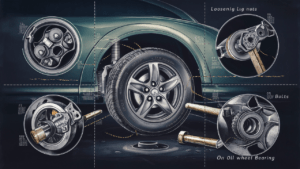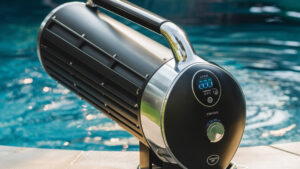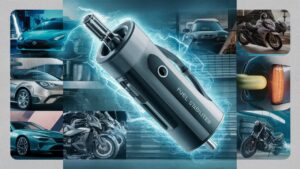To convert a folding bike to electric, replace the front wheel with a Swytch motor wheel, fit the pedal sensor around the pedals, fix the handlebar mount for the Power Pack, and connect all the wires. This conversion allows you to enjoy the benefits of an electric bike without having to purchase a new one.
Not only is it a cost-effective solution, but it also provides flexibility and convenience for your commuting or recreational needs. With a folding electric bike, you can easily transport and store it, while still benefiting from the motor assist when needed.
Experience the power and efficiency of an electric bike by converting your folding bike today.
Introduction To E-bike Conversion
Looking to convert your folding bike into an electric one? Discover how to do just that with our step-by-step guide. From replacing the front wheel with a motor wheel to connecting the wires, we’ll show you how to unleash the power of an e-bike conversion.
Benefits Of Electric Folding Bikes
Electric folding bikes offer numerous advantages, combining the convenience and portability of a folding bike with the power and efficiency of an electric motor. These bikes are perfect for urban commuters and recreational riders alike, as they provide a smooth and effortless riding experience. With the ability to fold and unfold quickly, they are also easy to store and transport, making them ideal for multi-modal transportation. Additionally, the electric assistance allows riders to tackle inclines and cover longer distances without breaking a sweat.
Choosing The Right Conversion Kit
When considering an e-bike conversion, it’s crucial to select the right conversion kit for your folding bike. The right kit will seamlessly integrate with your bike’s frame, ensuring a harmonious and efficient electric riding experience. Factors to consider include the motor power, battery capacity, and compatibility with your bike’s existing components. It’s essential to choose a kit that meets your specific riding needs and preferences, whether it’s for daily commuting or recreational adventures.
Tools And Materials Needed
If you’re looking to convert your folding bike into an electric one, you’ll need a few essential tools and materials to get the job done. With the right equipment, you’ll be able to enjoy the benefits of an electric bike while still having the convenience of a folding design. Here’s a checklist of the tools and materials you’ll need:
Essential Tools For The Job
- Wrench set
- Screwdriver set
- Allen key set
- Wire cutters
- Wire strippers
- Electrical tape
- Multimeter
- Drill
- Drill bits
- Pliers
- Zip ties
Materials Checklist Before Starting
- Electric bike conversion kit
- Electric motor
- Battery pack
- Controller
- Throttle
- Pedal sensor
- Power cables
- Mounting brackets
- Velcro straps
- Waterproof connectors
- Lubricant
Before starting the conversion process, make sure you have all the necessary tools and materials listed above. It’s important to have the right tools to ensure a smooth and successful conversion. Additionally, having the required materials will allow you to properly install the electric components onto your folding bike.
Remember to double-check the compatibility of the electric bike conversion kit with your folding bike before making a purchase. This will ensure that the kit fits and functions properly on your bike.
Converting your folding bike to electric can be a fun and rewarding project. With the right tools and materials, you’ll be able to transform your bike into an efficient and convenient mode of transportation. Stay tuned for the next section of this blog post, where we’ll guide you through the step-by-step process of converting your folding bike to electric.
Selecting The Motor Type
When it comes to converting your folding bike to electric, one of the key decisions you’ll need to make is selecting the motor type. The motor is the heart of your electric bike conversion, providing the power to propel you forward. There are two main types of motors to choose from: front hub motors and rear hub motors.
Front Hub Vs Rear Hub Motors
Front hub motors are installed in the front wheel of your bike, while rear hub motors are installed in the rear wheel. Each type has its own advantages and considerations to keep in mind.
| Front Hub Motors | Rear Hub Motors |
|---|---|
|
|
Determining The Appropriate Wattage
Another important consideration when selecting a motor is determining the appropriate wattage. The wattage of the motor determines the power output and performance of your electric bike. The higher the wattage, the more power the motor can deliver. Here are some factors to consider:
- Rider weight: Heavier riders may benefit from higher wattage motors to ensure sufficient power and performance.
- Terrain: If you frequently ride on hilly terrains, a higher wattage motor can provide the necessary torque to conquer steep inclines.
- Speed requirements: If you desire higher speeds, a motor with higher wattage can help you achieve your desired velocity.
It’s important to strike a balance between power and efficiency when selecting the wattage of your motor. Choosing a motor with too high wattage may drain your battery quickly, while a motor with too low wattage may not provide enough power for your needs.
By carefully considering the advantages and considerations of front hub and rear hub motors, as well as determining the appropriate wattage for your riding preferences, you can make an informed decision when selecting the motor type for your folding bike conversion. Stay tuned for our next blog post, where we’ll discuss the battery options for your electric bike!
Battery Selection And Installation
When converting a folding bike to electric, selecting the right battery and installing it properly are crucial steps. The battery type and capacity, as well as the method of mounting the battery safely, play a significant role in the overall performance and safety of the electric conversion.
Battery Types And Capacities
When choosing a battery for your electric folding bike, it’s essential to consider the different types and capacities available. The most common types of batteries for electric bikes are lithium-ion (Li-ion) and lithium polymer (LiPo). Li-ion batteries are known for their high energy density, long lifespan, and lightweight nature, making them an ideal choice for folding bike conversions. On the other hand, LiPo batteries are known for their high discharge rates, which can provide a boost in performance for electric bikes.
When selecting a battery for your folding bike conversion, consider the capacity in terms of voltage and ampere-hours (Ah). Higher voltage batteries can provide more power, while higher Ah ratings indicate longer range. It’s important to balance the desired power and range based on your specific riding needs.
Mounting The Battery Safely
Properly mounting the battery is essential to ensure safety and stability during rides. Most folding bikes have limited space for battery installation, so it’s crucial to choose a compact and lightweight battery that can be securely mounted onto the bike frame or the rear rack. The battery should be positioned in a way that maintains the bike’s balance and stability, without obstructing the folding mechanism or affecting the rider’s comfort.
Ensure that the mounting hardware is robust and designed to withstand the vibrations and shocks experienced during riding. Additionally, it’s important to follow the manufacturer’s guidelines for battery installation to prevent any potential hazards and ensure optimal performance.
Preparing The Folding Bike
Looking to convert your folding bike to electric? Follow these steps to prepare your bike: 1. Replace the front wheel with an electric motor wheel. 2. Install a pedal sensor around the pedals. 3. Attach a handlebar mount for the power pack.
4. Connect all the wires and you’re ready to go! With these simple modifications, you can enjoy the benefits of an electric folding bike.
Preparing the Folding Bike
Converting your folding bike to electric can be a great way to enhance your cycling experience. However, before you can start enjoying the benefits of an electric bike, you’ll need to prepare your folding bike for the conversion process. This involves disassembling certain parts of the bike and considering wheel and tire options. In this post, we’ll take a closer look at these steps to help you get started.
Disassembly Process
The first step in preparing your folding bike for an electric conversion is to disassemble it. This involves removing the front wheel, handlebars, and pedals from the bike. You’ll also need to remove any accessories, such as lights or reflectors, that may get in the way of the conversion process. Once you’ve disassembled the bike, you can start to evaluate which parts you’ll need to replace or modify to make the bike electric.
Wheel and Tire Considerations
When it comes to converting your folding bike to electric, the type of wheel and tire you use can have a big impact on your riding experience. While you can use the existing wheels and tires on your bike, you may want to consider upgrading to a larger size or a tire with more tread. This can help to improve stability and traction, especially when riding at higher speeds or on rough terrain.
Additionally, you’ll need to choose a wheel that’s compatible with your electric motor. This may require you to purchase a specific wheel or modify your existing one to fit the motor. It’s important to choose a wheel that’s strong enough to handle the added weight of the motor and battery, while also providing a smooth and comfortable ride.
In conclusion, preparing your folding bike for an electric conversion requires careful consideration of which parts to disassemble and which wheel and tire options to choose. By taking the time to prepare your bike properly, you can ensure that your electric conversion is successful and that you’ll be able to enjoy all the benefits of an electric bike.
Installing The Motor
To install the motor for your folding bike conversion, start by removing the front wheel and replacing it with the Swytch motor wheel. Then, attach the pedal sensor and handlebar mount for the power pack. Finally, connect all the wires and you’re ready to go! By converting your bike to electric, you can enjoy the benefits of an e-bike without having to purchase a whole new one.
Installing the motor is the most crucial step when it comes to converting a folding bike to an electric bike. If done correctly, it can significantly improve the performance of your bike and give you the desired speed and power. In this section, we will discuss the step-by-step process of motor installation and tips for aligning and securing the motor.
Step-by-step Motor Installation
1. First, remove the front wheel of your folding bike and disconnect the brake cable.
2. Next, attach the motor bracket to the front fork of your bike using the provided hardware.
3. Now, slide the motor into the bracket and align the axle with the fork dropouts.
4. Tighten the nuts on the axle to secure the motor in place.
5. Connect the motor wires to the controller wires using the provided connectors.
6. Attach the controller to the frame of the bike using zip ties or clamps.
7. Reconnect the brake cable and adjust it according to the manufacturer’s instructions.
8. Finally, mount the battery on the bike using the provided mounting bracket and connect it to the controller.
Tips For Aligning And Securing
1. Make sure that the motor is aligned properly with the front fork dropouts.
2. Tighten the nuts on the axle evenly to prevent the motor from shifting during use.
3. Use Loctite or a similar thread-locking compound on the nuts to ensure they stay tight.
4. Secure the controller to the frame using zip ties or clamps to prevent it from bouncing around while riding.
5. Route the wires neatly to avoid interference with the bike’s moving parts.
6. Test the motor and controller before taking your bike for a ride to ensure everything is working correctly.
By following these step-by-step instructions and tips, you can easily install the motor on your folding bike and enjoy the benefits of an electric bike. Remember to always wear a helmet and follow the traffic rules while riding your bike.
Wiring And Electronics Setup
When it comes to converting your folding bike into an electric one, one of the most important steps is the wiring and electronics setup. This is where you connect the motor to the battery and set up the control system. In this section, we will guide you through the process step by step.
Connecting The Motor To The Battery
The first step in the wiring and electronics setup is connecting the motor to the battery. This is a crucial step as it determines the power source for your electric bike. Here’s how you can do it:
- Start by identifying the positive and negative terminals on both the motor and the battery.
- Connect the positive terminal of the motor to the positive terminal of the battery using a suitable wire.
- Similarly, connect the negative terminal of the motor to the negative terminal of the battery.
- Ensure that the connections are secure and well-insulated to prevent any short circuits.
Once you have successfully connected the motor to the battery, you can move on to setting up the control system.
Setting Up The Control System
The control system is responsible for managing the speed and other functionalities of your electric folding bike. Here’s how you can set it up:
- Start by identifying the necessary components for the control system, such as the throttle, controller, and display.
- Mount the throttle on the handlebar of your folding bike, ensuring easy access while riding.
- Connect the throttle to the controller using the provided wiring harness, following the manufacturer’s instructions.
- Mount the controller in a secure location on your bike, ensuring protection from water and other elements.
- Connect the controller to the motor using the appropriate wiring, making sure the connections are secure.
- Finally, install the display on your handlebar, allowing you to monitor and control the electric assist level.
Once you have completed the wiring and electronics setup, you are ready to enjoy your newly converted electric folding bike. Remember to test all the connections and functionalities before taking it for a ride.

Testing And Troubleshooting
After converting your folding bike to electric, it’s crucial to perform thorough testing and be prepared to troubleshoot any issues that may arise. This ensures a smooth and safe riding experience with your newly electrified bike. In this section, we’ll cover the initial testing procedures and common issues you may encounter, along with their fixes.
Initial Testing Procedures
Before hitting the road, it’s essential to conduct comprehensive testing to ensure the proper functioning of your electric folding bike. Here are the initial testing procedures to follow:
- Check the battery connection and ensure it is securely attached to the bike frame.
- Test the motor functionality by engaging the throttle or pedal assist system.
- Inspect the brakes to ensure they are responsive and effectively stop the bike.
- Verify the functionality of the lights and other electronic components.
- Test the overall performance of the electric system in a controlled environment.
Common Issues And Fixes
Despite meticulous planning, issues may still arise with your electric bike. Here are some common problems you might encounter and their corresponding fixes:
| Common Issue | Fix |
|---|---|
| The motor is not engaging | Check the motor connections and ensure they are properly secured. Inspect the throttle or pedal assist sensor for any issues. |
| Poor battery performance | Verify the battery connections and charging status. Consider replacing the battery if performance does not improve. |
| Brake interference with motor | Adjust the brake system to ensure it does not interfere with the motor or electric components. Properly align the brake pads for optimal functionality. |
| Electrical system malfunctions | Inspect all wiring connections for loose or damaged components. Test each electrical element individually to identify the source of the malfunction. |
Safety Checks And Final Adjustments
When it comes to converting a folding bike to electric, safety checks and final adjustments are crucial to ensure a smooth and secure ride. By paying attention to brake and gear integration, as well as ensuring stability and handling, you can enjoy the benefits of an electric folding bike with peace of mind.
Brake And Gear Integration
Integrating the brakes and gears properly is essential for the safe operation of your electric folding bike. Before embarking on your first ride, check that the brake pads are aligned correctly and have sufficient grip. Ensure that the gear shifting mechanism is functioning smoothly and that the chain is properly lubricated.
In addition, it’s important to adjust the brake levers and gear shifters to a comfortable position, allowing for easy access and control while riding. This will enhance your overall riding experience and improve your safety on the road.
Ensuring Stability And Handling
As folding bikes have a compact design, it’s crucial to ensure stability and handling, especially when converting them to electric. Begin by inspecting the frame and components for any signs of damage or wear. Tighten all the bolts and screws to ensure everything is secure.
Next, check the tire pressure and make sure they are properly inflated. This will not only improve your stability but also enhance the overall performance of your electric folding bike. Additionally, consider upgrading to wider tires for better grip and stability, especially if you plan to ride on uneven or rough terrain.
Another important aspect of stability is the suspension system. Adjust the suspension to a suitable setting based on your weight and riding preferences. This will help absorb shocks and vibrations, providing a smoother and more comfortable ride.
Finally, perform a test ride in a safe and controlled environment to ensure that your electric folding bike handles well and maintains stability. Pay attention to any unusual noises or vibrations and make any necessary adjustments to optimize your riding experience.
By following these safety checks and making the final adjustments, you can convert your folding bike to electric with confidence. Remember to prioritize your safety and always wear appropriate protective gear when riding your electric folding bike.
Maintenance And Care
Converting your folding bike to electric not only enhances its performance but also requires proper maintenance and care to ensure longevity and optimal functionality. Whether it’s routine maintenance tips or ensuring the longevity of the battery, taking care of your electric folding bike is essential for a smooth and enjoyable riding experience.
Routine Maintenance Tips
Regular maintenance is crucial for the smooth operation of your electric folding bike. Here are some essential routine maintenance tips to keep your bike in top condition:
- Keep the bike clean and free from dirt and debris.
- Check tire pressure regularly and inflate as needed.
- Inspect brakes, gears, and chain for wear and tear.
- Ensure all electrical connections are secure and free from corrosion.
- Regularly lubricate moving parts to prevent rust and ensure smooth operation.
Battery Care And Longevity
Proper care of the battery is paramount for the longevity and performance of your electric folding bike. Here are some tips to ensure the care and longevity of your bike’s battery:
- Charge the battery as per the manufacturer’s guidelines to avoid overcharging.
- Store the bike in a cool, dry place to prevent extreme temperature exposure.
- Avoid complete discharge of the battery and recharge before it depletes fully.
- Regularly check the battery for any signs of damage or wear.
- Follow the recommended maintenance schedule for the battery as per the user manual.
Cost Analysis
Converting a folding bike to electric involves a thorough cost analysis to determine the most economical approach. Let’s delve into the various cost considerations to help you make an informed decision.
Comparing Costs: Diy Vs. Pre-built
When converting a folding bike to electric, it’s essential to weigh the costs of a do-it-yourself (DIY) conversion against purchasing a pre-built electric folding bike. Comparing these costs can help in deciding the most cost-effective option.
Budgeting For Replacement Parts
Another crucial aspect of the cost analysis is budgeting for replacement parts. Understanding the potential expenses for maintenance and replacement parts ensures that you can factor in these costs when planning your electric folding bike conversion.
Legal Considerations
Converting a folding bike to electric requires careful consideration of legal regulations. It’s essential to comply with local laws regarding e-bike conversions, including speed limits, power output, and where electric bikes are permitted. Researching and adhering to these legal requirements is crucial before embarking on a folding bike conversion project.
Legal Considerations:
When it comes to converting a folding bike to electric, there are several legal considerations that you need to keep in mind. Understanding the e-bike laws, modifications, and insurance implications are crucial before you hit the road. Here’s what you need to know:
Understanding E-bike Laws
Before you start converting your folding bike to electric, it’s important to understand the e-bike laws in your region. In the US, e-bikes are classified as bicycles if they have a maximum speed of 20 mph and a motor that produces less than 750 watts. However, laws vary from state to state, and it’s important to check the regulations in your area before making any modifications.
Modifications And Insurance Implications
Converting your folding bike to electric involves several modifications, including adding a motor, battery, and controller. It’s important to note that these modifications may have insurance implications. Some insurance companies may not cover e-bike accidents if the bike has been modified. Therefore, it’s essential to check with your insurance provider before making any modifications to your folding bike.
Additionally, it’s important to ensure that your e-bike meets safety standards. The motor and battery should be properly secured, and the brakes and lights should be in good working condition. Failure to comply with safety standards could lead to accidents and legal issues.
In conclusion, converting a folding bike to electric can be a fun and eco-friendly way to commute. However, it’s crucial to keep legal considerations in mind before making any modifications. Understanding the e-bike laws, modifications, and insurance implications can help you stay safe and avoid legal issues.
Frequently Asked Questions
How Much Does It Cost To Convert A Bike To Electric?
Converting a bike to electric can cost between $500 to $1500, depending on the type of conversion kit used.
Is It Cheaper To Convert A Bike To Electric?
Converting a bike to electric is generally cheaper than buying a new electric bike. By purchasing a conversion kit, you only need to buy the components to give your bike power, rather than buying a whole new bike. This option is cost-effective and allows you to enjoy the benefits of an electric bike without breaking the bank.
Are E-bike Conversion Kits Worth It?
E-bike conversion kits are worth it for cost savings and similar benefits to electric bikes.
What Is The Disadvantage Of Folding Ebike?
The disadvantage of a folding eBike is that its compact design sacrifices stability for portability. With smaller wheels and a shorter wheelbase, these bikes may not offer the same level of stability and control as full-sized bicycles, especially at higher speeds or on rough terrain.
Conclusion
Converting a folding bike to electric is a great way to upgrade your ride and make it more efficient. With the right conversion kit and some basic tools, you can easily transform your bike into an electric one. Not only is it a cost-effective option compared to buying a new e-bike, but it also allows you to customize your ride according to your preferences.
Whether you’re looking for a boost on your daily commute or a fun way to explore the outdoors, converting your folding bike to electric is definitely worth considering.








